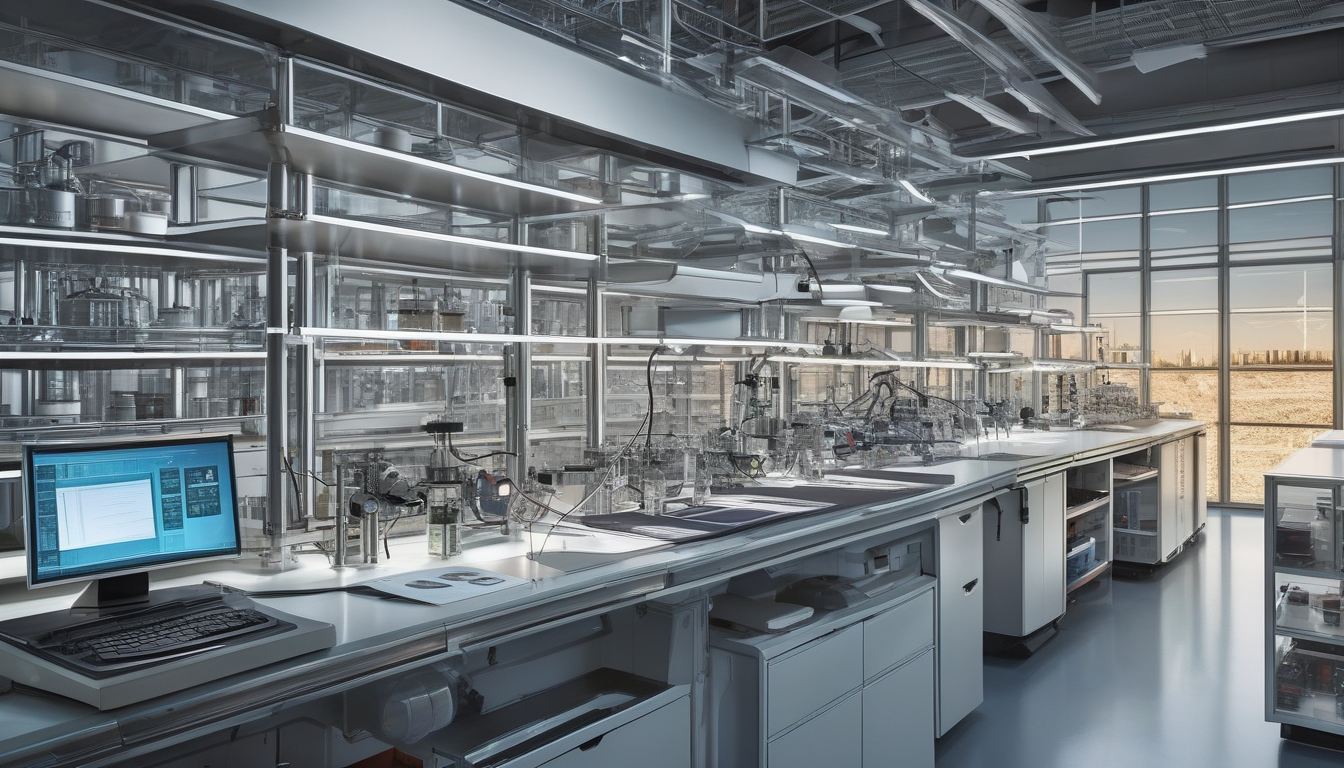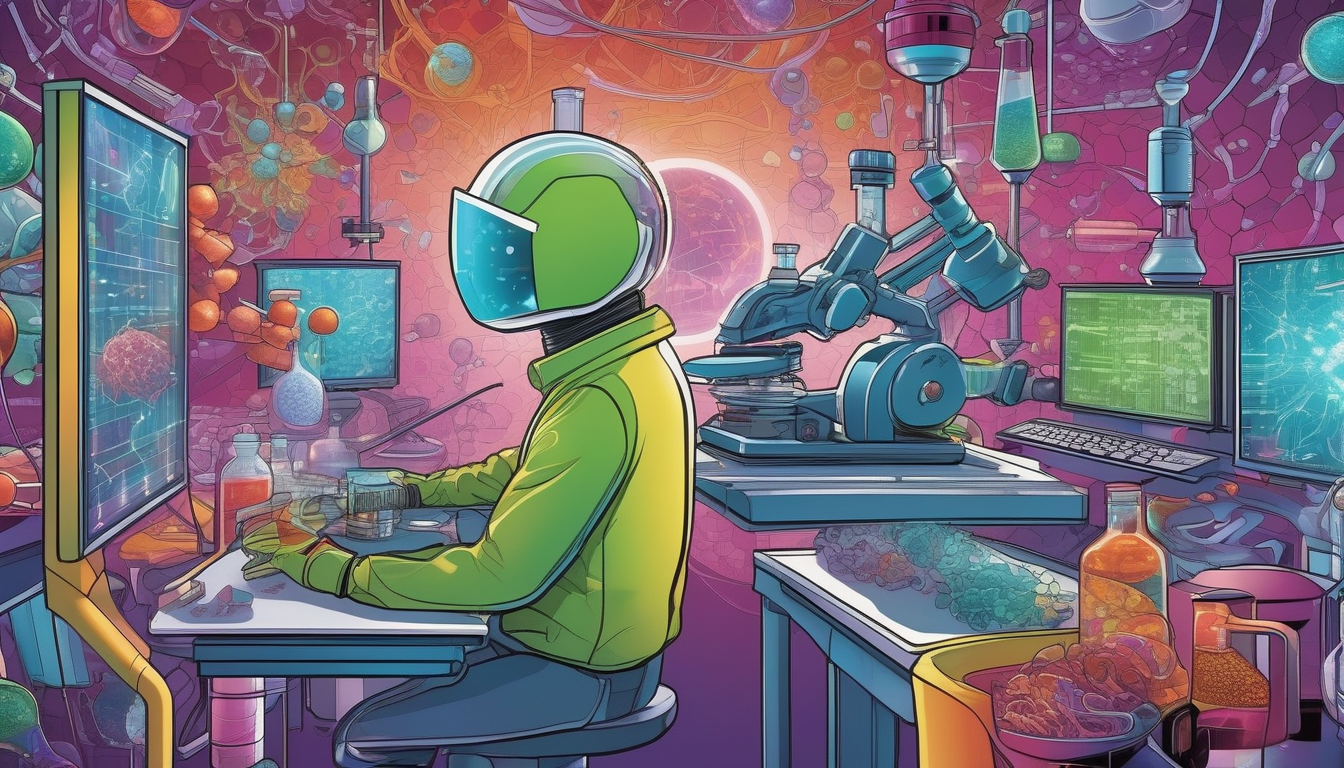How Nanotechnology is Changing the World

This article explores the transformative impact of nanotechnology across various fields, highlighting its applications, benefits, and future potential in improving health, technology, and the environment.
Nanotechnology involves manipulating matter at the atomic and molecular scale, leading to groundbreaking advancements across numerous industries. Imagine being able to control materials at a level so tiny that it’s almost invisible! This manipulation allows scientists and engineers to create new materials and devices with unique properties that can revolutionize everything from electronics to healthcare. Understanding its principles is essential for grasping its significance in modern science and technology. The possibilities are endless, and the implications for our future are profound.
Nanotechnology is revolutionizing medicine through targeted drug delivery, advanced imaging techniques, and regenerative medicine. These innovations promise to enhance treatment efficacy and improve patient outcomes significantly. For instance, think about how frustrating it can be to deal with the side effects of traditional medications. With nanotechnology, we can minimize those effects by directing drugs precisely where they are needed. This approach not only makes treatment more effective but also improves the quality of life for patients.
By utilizing nanoparticles, targeted drug delivery systems can direct medication precisely to diseased cells, minimizing side effects and maximizing therapeutic effects. This approach represents a significant leap in personalized medicine. Imagine a tiny delivery truck that knows exactly where to go, dropping off medicine right at the doorstep of sick cells while leaving healthy ones untouched. This is the future of medicine!
Nanoparticles are increasingly used in cancer therapies, enabling localized treatment that spares healthy tissues. This method enhances the effectiveness of chemotherapy while reducing adverse reactions. It’s like having a sniper instead of a cannon; precision is key in the battle against cancer.
Nanotechnology enhances diagnostic capabilities through the development of highly sensitive biosensors and imaging agents, allowing for early detection of diseases and more accurate monitoring of health conditions. Early detection can be a game-changer, allowing for timely interventions that can save lives.
Nanotechnology plays a crucial role in regenerative medicine, aiding in tissue engineering and the development of biomaterials that promote healing and regeneration of damaged tissues. Imagine a world where damaged organs can be repaired or even replaced with lab-grown tissues—thanks to nanotechnology, this dream is becoming a reality.
Nanotechnology offers innovative solutions for environmental challenges, including pollution remediation, water purification, and sustainable energy production, contributing to a cleaner and more sustainable planet. With the world facing severe environmental issues, the need for effective solutions is more urgent than ever.
Nanotechnology enhances water purification processes by enabling the development of advanced filtration systems that can remove contaminants at the nanoscale, ensuring access to safe drinking water. This technology is crucial in areas where clean water is scarce, providing hope for millions.
Nanomaterials are utilized in pollution control, effectively capturing and degrading pollutants in air and water, thereby improving environmental quality and public health. Just think about the fresh air and clean water we could achieve with these advanced technologies!
The future of nanotechnology holds immense potential, with ongoing research promising advancements in various sectors, including electronics, energy storage, and agriculture, paving the way for a more efficient and sustainable world. As we continue to explore the nano world, who knows what incredible breakthroughs await us?

Introduction to Nanotechnology
Nanotechnology involves manipulating matter at an incredibly small scale, typically between 1 to 100 nanometers. To put that into perspective, a nanometer is one-billionth of a meter! This field of science has opened up a world of possibilities, leading to groundbreaking advancements across various industries. Imagine being able to control materials at the atomic level—it’s like being a magician who can alter reality by reshaping the very building blocks of matter.
The significance of nanotechnology in modern science and technology cannot be overstated. It serves as a bridge connecting various disciplines, from physics to biology, and even engineering. By understanding the principles of nanotechnology, we can appreciate its transformative potential. For instance, consider how nanomaterials can enhance the properties of everyday products. They can make fabrics stain-resistant, improve the efficiency of solar panels, and even help in the development of new medicines that target diseases more effectively.
The applications of nanotechnology are vast and varied, impacting our lives in ways we may not even realize. Here are a few key areas where nanotechnology is making waves:
- Medicine: From targeted drug delivery to advanced imaging techniques, nanotechnology is revolutionizing healthcare.
- Electronics: Smaller, faster, and more efficient devices are being developed thanks to nanoscale components.
- Environment: Innovative solutions for pollution control and sustainable energy production are emerging.
As we delve deeper into this fascinating field, it’s essential to recognize that the advancements we see today are just the tip of the iceberg. Ongoing research is continually uncovering new applications and benefits of nanotechnology, promising a future filled with exciting innovations. So, buckle up and get ready for a journey into the microscopic world where the possibilities are truly endless!

Applications in Medicine
Nanotechnology is revolutionizing the field of medicine in ways that were once thought to be the stuff of science fiction. Imagine a world where diseases can be targeted with pinpoint accuracy, where treatments are tailored specifically to individual patients, and where healing can occur at a cellular level. This is not just a dream; it is becoming a reality thanks to the incredible advancements in nanotechnology.
One of the most exciting applications of nanotechnology in medicine is in targeted drug delivery systems. By utilizing nanoparticles, scientists can create systems that deliver medication directly to diseased cells. This means that the medication is more effective and side effects are significantly reduced. It’s like having a guided missile that only hits the target, sparing the surrounding healthy cells from unnecessary damage. This approach is a game changer in the world of personalized medicine.
With the rise of nanoparticles, the ability to treat conditions such as cancer has become more sophisticated. Nanoparticles can be designed to release drugs in response to specific cellular signals, ensuring that the treatment is administered precisely when and where it is needed. For example, in cancer treatment, these nanoparticles can be engineered to accumulate in tumor sites, allowing for localized therapy that minimizes harm to healthy tissues. This not only enhances the effectiveness of chemotherapy but also reduces the adverse reactions that often accompany traditional treatments.
In the realm of cancer therapies, nanoparticles are proving to be invaluable. They can enhance the potency of chemotherapy while simultaneously protecting healthy cells. This is akin to using a surgical scalpel instead of a blunt instrument; the precision offered by nanotechnology allows for targeted interventions that can significantly improve patient outcomes.
Moreover, nanotechnology is enhancing diagnostic capabilities through the development of highly sensitive biosensors and imaging agents. These innovations allow for early detection of diseases, which is crucial for effective treatment. With the ability to detect diseases at their earliest stages, healthcare providers can intervene sooner, leading to better health outcomes. In essence, nanotechnology is not only about treatment but also about prevention and early intervention.
As we continue to explore the potential of nanotechnology in medicine, the possibilities seem limitless. From improving drug delivery to enhancing diagnostic tools, this field is paving the way for a healthier future.
Targeted Drug Delivery Systems
Imagine a world where medicine works like a precision-guided missile, striking only the target while leaving everything else unscathed. make this dream a reality by using nanoparticles to transport medications directly to diseased cells. This innovative approach not only minimizes side effects but also maximizes the therapeutic effects of treatments. It’s like having a skilled archer in a world of blunt instruments—precision is key!
The beauty of targeted drug delivery lies in its ability to adapt to the unique characteristics of individual patients. By tailoring treatments to the specific needs of each patient, healthcare providers can significantly enhance treatment efficacy. For instance, in cancer therapy, these systems can deliver chemotherapy drugs directly to tumor cells, sparing healthy tissues and reducing the harsh side effects typically associated with traditional chemotherapy. This leap towards personalized medicine is nothing short of revolutionary.
To illustrate the impact of these systems, consider the following benefits:
- Reduced Side Effects: By targeting only the affected areas, patients experience fewer adverse reactions.
- Increased Efficiency: Medications can work faster and more effectively when delivered directly to the source of the problem.
- Improved Patient Compliance: With fewer side effects, patients are more likely to stick to their treatment plans.
One of the most exciting applications of targeted drug delivery is in the realm of cancer treatment. Nanoparticles can be engineered to recognize specific markers on cancer cells, ensuring that the drugs are delivered precisely where they are needed. This not only enhances the effectiveness of the treatment but also opens new doors for therapies that were once deemed too risky due to potential damage to healthy cells.
In conclusion, targeted drug delivery systems represent a significant advancement in the field of medicine. As research continues to evolve, we can expect even more innovative solutions that harness the power of nanotechnology, ultimately transforming the way we approach treatment and patient care. The future is bright, and with these advancements, we are one step closer to a world where medicine is as precise as it is effective.
Nanoparticles in Cancer Treatment
Cancer treatment has long been a daunting challenge, but the advent of nanoparticles is revolutionizing the way we approach this battle. Imagine tiny, engineered particles that can navigate through the bloodstream, targeting only the malignant cells while leaving the healthy ones untouched. This is the magic of nanotechnology in cancer therapy. By utilizing these minuscule agents, doctors can now deliver drugs directly to the tumor site, significantly enhancing the effectiveness of treatments while minimizing side effects.
One of the most exciting aspects of using nanoparticles in cancer treatment is their ability to enhance chemotherapy. Traditional chemotherapy often affects not just cancer cells but also healthy cells, leading to severe side effects like nausea and hair loss. However, with targeted drug delivery systems, nanoparticles can encapsulate chemotherapy drugs and release them in a controlled manner precisely where they are needed. This targeted approach not only improves the drug’s potency but also reduces the collateral damage to healthy tissues, making the treatment much more tolerable for patients.
For instance, researchers are developing nanoparticles that can be activated by specific triggers, such as changes in pH or temperature found in tumor environments. When these nanoparticles reach the cancer cells, they can release their drug payload, effectively attacking the tumor from within. This method is akin to having a guided missile that knows exactly where to strike, ensuring that the damage is confined to the enemy while sparing friendly territory.
Furthermore, nanoparticles can also play a crucial role in imaging techniques used for cancer diagnosis. By enhancing the contrast in imaging scans, these particles allow for earlier and more accurate detection of tumors, which is vital for successful treatment outcomes. With their ability to improve both treatment and diagnostic capabilities, nanoparticles are indeed a game-changer in the fight against cancer.
In summary, the integration of nanoparticles in cancer treatment is paving the way for a new era of personalized medicine. With ongoing research and clinical trials, the hope is that these tiny warriors will one day lead to more effective and less invasive cancer therapies, bringing us closer to a world where cancer is no longer a death sentence but a manageable condition.
Nanotechnology in Diagnostics
Imagine a world where diseases can be detected before they even start showing symptoms—sounds like science fiction, right? Well, thanks to nanotechnology, this is becoming a reality! By leveraging the unique properties of nanoparticles, researchers are developing highly sensitive biosensors and imaging agents that can revolutionize the way we diagnose illnesses.
These advanced diagnostic tools work at the nanoscale, allowing for the detection of biomarkers that are present in minuscule quantities. This means that conditions like cancer, diabetes, and infectious diseases can be identified much earlier than traditional methods allow. The precision of these technologies not only enhances the accuracy of diagnoses but also reduces the chances of false positives, leading to better patient management.
One of the most exciting developments in this field is the use of quantum dots—tiny semiconductor particles that emit light when illuminated. When used in imaging techniques, quantum dots can highlight specific cells or tissues, making it easier for doctors to pinpoint abnormalities. This technology offers a promising alternative to conventional imaging methods, which can be less sensitive and more invasive.
Moreover, the integration of nanotechnology in diagnostics facilitates the creation of portable devices. These devices can be used in remote areas or in emergency situations, providing immediate results without the need for extensive laboratory setups. For instance, point-of-care testing devices that utilize nanotechnology can deliver rapid results for conditions like strep throat or HIV, which is crucial in time-sensitive situations.
In summary, the impact of nanotechnology in diagnostics is profound. It not only enhances the ability to detect diseases early but also improves the overall efficiency of healthcare systems. As research continues to advance, we can expect even more innovative solutions that will ultimately save lives and enhance the quality of care. The future of diagnostics is bright, and it’s all thanks to the tiny wonders of nanotechnology!
Regenerative Medicine Innovations
Nano-technology is a game changer in the field of regenerative medicine, where it plays a pivotal role in developing innovative solutions that promote healing and tissue regeneration. Imagine being able to repair damaged organs or tissues using materials that are so small they can interact with cells at the molecular level. This is not science fiction; it’s happening right now, thanks to the advancements in nanotechnology.
At the heart of these innovations are nanomaterials, which are designed to mimic the natural environment of cells. These materials can support cell growth and differentiation, making them invaluable for tissue engineering. For instance, researchers are developing scaffolds made from nanoscale fibers that provide a supportive structure for cells to grow on. This approach not only enhances the healing process but also improves the functionality of the regenerated tissue.
Furthermore, nanotechnology facilitates the delivery of growth factors and other therapeutic agents directly to the site of injury. This targeted approach ensures that the right amount of medication reaches the right place at the right time, significantly increasing the chances of successful healing. Imagine a tiny delivery system that knows exactly where to go in your body—this is what nanotechnology offers.
Some key innovations in regenerative medicine through nanotechnology include:
- Stem Cell Therapy: Nanoparticles can enhance the survival and differentiation of stem cells, which are crucial for repairing damaged tissues.
- Smart Biomaterials: These materials can respond to environmental stimuli, releasing therapeutic agents only when needed, thereby minimizing side effects.
- 3D Bioprinting: Combining nanotechnology with 3D printing allows for the creation of complex tissue structures that closely resemble natural tissues.
The potential of nanotechnology in regenerative medicine is enormous. As research continues, we can expect to see even more groundbreaking applications that could transform how we approach healing and recovery. Imagine a future where injuries heal faster, organs regenerate, and the quality of life improves dramatically—all thanks to the tiny innovations happening at the nanoscale.

Environmental Applications
Nanotechnology is emerging as a game-changer in tackling some of the most pressing environmental challenges we face today. With the ability to manipulate materials at the atomic level, nanotech offers innovative solutions that can significantly reduce pollution, enhance water quality, and promote sustainable energy practices. Imagine a world where contaminants are efficiently removed from our water sources and air quality is dramatically improved—this is the promise of nanotechnology.
One of the most exciting applications of nanotechnology is in water purification. Traditional methods often fall short when it comes to removing tiny pollutants and pathogens. However, nanotechnology has paved the way for advanced filtration systems that can target and eliminate contaminants at the nanoscale. These systems can effectively filter out harmful substances, ensuring that communities have access to clean and safe drinking water. For instance, nanomaterials like silver and titanium dioxide are being used to create filters that not only trap impurities but also have antimicrobial properties, further enhancing water safety.
Moreover, nanotechnology plays a crucial role in pollution control and remediation. By utilizing nanomaterials, researchers are developing methods to capture and degrade pollutants in both air and water. For example, nanoscale catalysts can break down harmful chemicals into less toxic substances, while nanostructured materials can absorb heavy metals and other pollutants, rendering them harmless. This is crucial for improving environmental quality and protecting public health.
To put these innovations into perspective, here’s a brief overview of how nanotechnology is making a difference:
| Application | Description |
|---|---|
| Water Purification | Advanced filtration systems that remove contaminants at the nanoscale. |
| Pollution Remediation | Nanoscale materials that capture and degrade pollutants in air and water. |
| Sustainable Energy | Nanotechnology in solar cells and batteries for more efficient energy use. |
As we look to the future, the potential of nanotechnology in environmental applications is vast. Ongoing research continues to uncover new ways to harness these tiny materials for the greater good, paving the way for a cleaner, healthier planet. The fusion of science and technology is not just a dream; it’s a reality that is unfolding right before our eyes, and it’s one we should all be excited about.
Water Purification Technologies
Water purification technologies have taken a giant leap forward thanks to nanotechnology. Imagine being able to clean water so effectively that even the tiniest contaminants are removed. This is not just a dream; it’s a reality made possible by manipulating materials at the nanoscale. Traditional methods of water purification often struggle with efficiency and effectiveness, but nanotechnology offers innovative solutions that are both practical and powerful.
One of the standout innovations in this field is the development of advanced filtration systems that utilize nanomaterials. These materials have unique properties that allow them to capture contaminants that are otherwise invisible to the naked eye. For instance, nanofilters can remove particles as small as a few nanometers, including bacteria, viruses, and harmful chemicals. This level of filtration ensures that the water is not just clean but also safe for consumption.
Furthermore, the use of nanoparticles in purification processes can enhance the efficiency of existing technologies. For example, photocatalytic nanoparticles can break down organic pollutants when exposed to light. This means that not only are we filtering out impurities, but we are also actively degrading harmful substances in the water. This dual-action approach is a game changer in the quest for clean water.
To illustrate the effectiveness of these technologies, consider the following table that compares traditional water purification methods with those enhanced by nanotechnology:
| Purification Method | Efficiency | Contaminants Removed |
|---|---|---|
| Traditional Filtration | Moderate | Large particles, some bacteria |
| Nanotechnology Filtration | High | Bacteria, viruses, heavy metals, chemicals |
The implications of these advancements are profound. Access to clean drinking water is a fundamental human right, yet millions still lack it. By harnessing the power of nanotechnology, we can address this global challenge head-on. As research continues and new technologies emerge, the future looks bright for water purification, promising a world where everyone has access to safe, clean water.
Pollution Control and Remediation
In today’s world, pollution is a pressing issue that affects our health, environment, and overall quality of life. Nanotechnology is stepping in as a game changer, offering innovative solutions for pollution control and remediation. By utilizing nanomaterials, scientists and engineers can develop methods that effectively capture and degrade pollutants in both air and water, leading to a cleaner environment. Imagine having the power to clean our planet at a molecular level—this is precisely what nanotechnology enables.
One of the most exciting applications of nanotechnology in pollution control is the use of nanoparticles for air purification. These tiny particles can adsorb harmful gases and particulate matter, significantly improving air quality. For instance, researchers have developed filters that incorporate nanomaterials to trap pollutants, making the air we breathe much safer. It’s like having a superhero in our atmosphere, fighting off the villains of pollution!
In terms of water purification, nanotechnology offers groundbreaking advancements. Traditional water treatment methods often struggle to remove certain contaminants, but nanotechnology can tackle these challenges head-on. Advanced filtration systems utilizing nanomaterials can remove bacteria, viruses, and heavy metals with remarkable efficiency. A study revealed that these systems can reduce contaminants by over 90%, ensuring access to safe drinking water for communities worldwide.
Furthermore, nanomaterials can also be employed in soil remediation, where they help to degrade harmful substances and restore contaminated land. This process not only cleans the soil but also promotes the growth of healthy plants, creating a thriving ecosystem. The table below summarizes some key applications of nanotechnology in pollution control and remediation:
| Application | Description |
|---|---|
| Air Purification | Nanoparticles capture harmful gases and particulate matter. |
| Water Purification | Advanced filtration systems remove bacteria, viruses, and heavy metals. |
| Soil Remediation | Nanomaterials help degrade harmful substances in contaminated land. |
As we look to the future, the potential of nanotechnology in combating pollution is vast. With ongoing research and development, we can expect even more innovative solutions that not only enhance our environment but also improve public health. Embracing these technologies could lead us towards a sustainable and cleaner planet, where pollution is no longer a threat but a challenge we have successfully overcome.

Future Prospects of Nanotechnology
Nano, the prefix that signifies a billionth of a meter, is not just a scientific term; it’s the gateway to a future brimming with possibilities. As we stand on the brink of a new technological era, the implications of nanotechnology stretch far beyond what we can currently imagine. From enhancing everyday products to revolutionizing entire industries, the potential applications are as vast as they are exciting.
One of the most promising areas lies in electronics. Imagine devices that are not only faster but also more energy-efficient. Nanotechnology can lead to the development of smaller, more powerful transistors, paving the way for ultra-fast computers and advanced communication systems. This leap in technology could transform how we interact with the digital world, making it more seamless and integrated into our daily lives.
Moreover, in the realm of energy storage, nanotechnology is set to play a critical role. With the growing demand for renewable energy sources, innovations in nanomaterials could lead to batteries that charge faster and last longer. These advancements could revolutionize electric vehicles, making them more viable for the average consumer and reducing our reliance on fossil fuels.
In agriculture, nanotechnology is poised to enhance food production and safety. By developing nanosensors that monitor soil health and crop conditions, farmers can make informed decisions that increase yield while minimizing environmental impact. Additionally, nano-fertilizers and pesticides can be designed to release nutrients more efficiently, promoting sustainable farming practices.
As these advancements unfold, it’s important to consider the ethical implications of nanotechnology. Discussions surrounding safety, environmental impact, and regulatory measures will be crucial in ensuring that these innovations benefit society as a whole. The future of nanotechnology is not just about what we can achieve but also about how we can do it responsibly.
In summary, the future prospects of nanotechnology are incredibly bright, with the potential to reshape industries and improve quality of life. As research continues to advance, we can only anticipate the remarkable innovations that lie ahead, making our world more efficient, sustainable, and interconnected.
Frequently Asked Questions
- What is nanotechnology?
Nanotechnology is the science of manipulating matter on an atomic and molecular scale, typically at sizes ranging from 1 to 100 nanometers. This field enables groundbreaking advancements in various industries, including medicine, electronics, and environmental science.
- How is nanotechnology used in medicine?
In medicine, nanotechnology is primarily used for targeted drug delivery, advanced imaging techniques, and regenerative medicine. By using nanoparticles, drugs can be delivered directly to diseased cells, enhancing treatment effectiveness while minimizing side effects.
- Can nanotechnology help in cancer treatment?
Absolutely! Nanotechnology plays a significant role in cancer therapies by allowing localized treatment that spares healthy tissues. This targeted approach improves the effectiveness of chemotherapy and reduces adverse reactions, making treatments safer and more efficient.
- What are the environmental applications of nanotechnology?
Nanotechnology offers innovative solutions for environmental issues, such as pollution remediation and water purification. Advanced nanomaterials can effectively capture pollutants and enhance filtration processes, contributing to cleaner air and water.
- What is the future potential of nanotechnology?
The future of nanotechnology is incredibly promising! Ongoing research is expected to lead to advancements in various sectors, including electronics, energy storage, and agriculture, paving the way for a more sustainable and efficient world.













